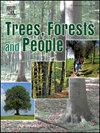Soil organic carbon drivers in a high-stock forested region
IF 2.7
Q1 FORESTRY
引用次数: 0
Abstract
Forests are pivotal in stocking Soil Organic Carbon (SOC). This study investigated the drivers influencing SOC stock in Chilean Patagonia, a region known for its extensive carbon reserves. We analysed the SOC stock (tons ha−1 at 30 cm depth) as the target variable, considering factors such as forest types (Nothofagus pumilio = NP, N. antarctica = NA, N. dombeyi-N. betuloides = ND-NB, evergreen = EV, and mixed broadleaved forests = MI), soil types (Andosols, Entisols, Inceptisols, and Spodosols), and human impacts (unmanaged = U, burned = B, harvesting = H, livestock = L, and harvesting + livestock = H + L). The analysis combined the SOC stock´s climatic, topographic, and above- and below-ground drivers. Data were evaluated using analyses of variance (ANOVAs), generalised linear models (GLMs), and principal component analyses (PCA). The results revealed significant differences (p < 0.001) in SOC stocks in forest types, soil types, and human impacts. The SOC stocks were higher in EV, NP, and ND-NB forests (SOC >119 tons ha−1) compared to MI and NA forests (SOC ∼100 tons ha−1). The highest SOC stocks were observed in U and H forests (SOC >125 tons ha−1), with Spodosols and Inceptisols showing the highest SOC levels among the soil types. The interaction between NP forests and harvesting presented a high SOC stock. PCAs identified two main groups influencing SOC variation: one related to climatic and topographic factors like seasonal temperatures and altitude and another associated with specific drivers such as pH, canopy cover, decaying wood, vascular plant cover, and lichen cover. We concluded that U and H forests in a region with high SOC stocks maintain equivalent SOC storage. However, special attention is needed for forest management practices involving integrated livestock in harvested forests.
高蓄积量林区土壤有机碳驱动因素研究
森林是储存土壤有机碳(SOC)的关键。本研究调查了智利巴塔哥尼亚地区碳储量丰富的驱动因素。考虑森林类型(Nothofagus pumilio = NP, N. antarctica = NA, N. dombeyi-N)等因素,以30 cm深度的碳储量(吨ha - 1)为目标变量进行分析。阔叶林= ND-NB,常绿= EV,混交林= MI),土壤类型(固溶土,原生土,Spodosols)和人类影响(未管理= U,焚烧= B,采伐= H,牲畜= L,采伐+牲畜= H + L)。该分析综合了土壤有机碳储量的气候、地形和地上、地下驱动因素。使用方差分析(ANOVAs)、广义线性模型(GLMs)和主成分分析(PCA)对数据进行评估。结果显示有显著差异(p <;0.001),森林类型、土壤类型和人类影响的有机碳储量。与MI和NA森林(SOC ~ 100 t ha - 1)相比,EV、NP和ND-NB森林的SOC储量(SOC >119 t ha - 1)更高。U型和H型森林的土壤有机碳储量最高(125 t ha - 1),其中spodosol和inceptisol的土壤有机碳含量最高。NP林与采伐的交互作用表现出较高的有机碳储量。pca确定了影响有机碳变化的两个主要群体:一个与季节温度和海拔等气候和地形因素有关,另一个与pH、冠层覆盖、腐烂木材、维管植物覆盖和地衣覆盖等特定驱动因素有关。结果表明,在有机碳储量高的地区,U和H林保持相当的有机碳储量。但是,需要特别注意涉及采伐森林中综合牲畜的森林管理做法。
本文章由计算机程序翻译,如有差异,请以英文原文为准。
求助全文
约1分钟内获得全文
求助全文
来源期刊

Trees, Forests and People
Economics, Econometrics and Finance-Economics, Econometrics and Finance (miscellaneous)
CiteScore
4.30
自引率
7.40%
发文量
172
审稿时长
56 days
 求助内容:
求助内容: 应助结果提醒方式:
应助结果提醒方式:


